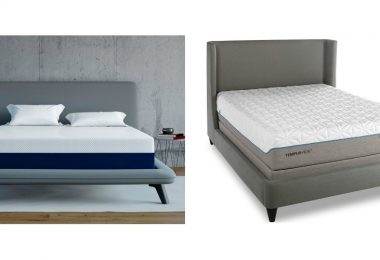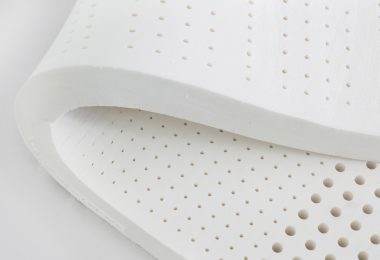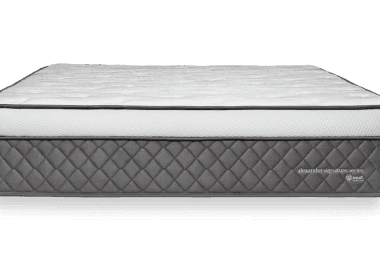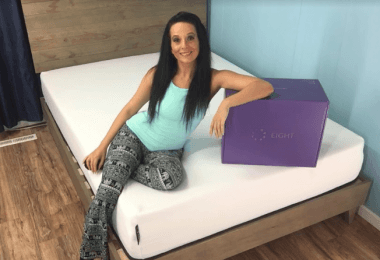In fact, it can often result in a variety of aches and pains coupled with the exhaustion that comes from a lack of sleep and that’s why there are times when a more solid mattress is the best way to go. And that’s what we’re here to discuss; the advantages of opting for that firmer sleep surface.
So, let’s talk about what exactly is a firm mattress. Not to be confused with the level of support it provides, a firm mattress is essentially the hardness of the mattress and its ability to yield when you sit or lay down on it.
The standard measure of firmness for a memory foam mattress is called an “ILD” rating (Indentation Load Deflection) and it refers to how much weight it will take to create a pre-determined depth of indentation and then return to its original form. Typically, the higher the ILD the firmer the mattress with a soft mattress in the “10” range and a firmer mattress around the “120” mark. Why does this matter? Because with memory foam the softer the mattress the more difficult it can be to move around, turn over and even get in and out of bed which can result in stiff joints in the morning.
With a spring-coil mattress, the firmness is determined by the gauge of wire used in the coil construction; the lower the gauge, the thicker and stiffer the wires and the firmer the mattress. If you’re looking to meld firm with ideal support, then pocketed coils are the route to take.
When it comes to shopping for a memory foam mattress, the easiest way to zero in on the firmness level that will meet your needs is to consider this: extra firm will range from a 9 to 10 and features very little “sinkage” with significant pushback when you lay down (think solid as a board). A mattress in the 7 to 8 category is classed as medium-firm to firm and you essentially sleep atop the surface, with a minimal amount of the hug-curving properties you would expect with memory foam. This is often ideal for heavier sleepers who may find the less firm designs give a little too much under their body weight. Those mattresses rated as a 6 will deliver a balance of both firmer surface and curve-hugging comfort and they are typically the level of firmness most consumers opt for.
Any mattress that comes in less than a “6” would be considered soft versus firm and we’ll look at those another time!
The Advantages of a Firm Mattress
- Both a firm and a medium-firm mattress will meet the needs of multiple sleep styles; stomach sleepers will want the cozy comfort of a medium-firm mattress that provides a little bit of “give” for your tummy region but not so much so that you feel you are sinking face first and need to surface every few minutes for air. Back sleepers will appreciate a firmer mattress because it keeps your back in a stable position that doesn’t allow you to sink in as you sleep… which will ultimately result in a stiff back in the morning.
- With a firmer mattress your body is allowed to naturally rest in a neutral position and what this means for you is that you’re not having to continually rouse from your sleep to readjust into a more comfortable position. By properly distributing your weight evenly, your entire body is able to relax and recharge as you sleep. The end result will be a deeper, more restful night and a much more energized morning.
- If you’re heavier (200-pounds plus) you’ll appreciate the benefits of a firm to medium-firm mattress because of its ability to resist your body weight and prevent that sense of sinking in too deeply. The cushioning comfort that comes with a memory foam mattress is great, but you don’t’ want to have to struggle each time you try to get in and out of bed or simply turn over in the night.
- For those who suffer from back or hip pain (one is often linked to the other) a medium-firm to firm memory foam mattress is the way to go because of its ability to deliver continually solid support to your back and lower lumbar region. No contorting or twisting to turn over in the night or sleeping at awkward angles that can throw your spine out of alignment.
- A firm memory foam or coil-spring mattress is also more versatile than their softer counterparts. If you find the surface too rigid for your sleep style, you can add a memory foam or gel foam topper to instantly deliver another layer of cushioning comfort that will better suit your sleep needs.
- If your partner tosses and turns in the night, you’ll find that a firmer memory foam mattress or a coil-spring mattress with individually pocketed coils will help to isolate motion rather than transfer it. What this means for you is that you won’t be awakened each time they roll over or get up in the night and will ultimately enjoy a deeper, more restful sleep.
A Level of Firm for Every Sleep Style
Each of us has a preferred sleep style that we naturally revert to either before we begin to fall asleep or sub-consciously, during the night. Whether you’re a stomach, side or back-sleeper, or if you’re simply prone to waking throughout the night, there is a level of firm that will help you achieve those much-needed zzzzz’s. Although we’ve touched on a few of these already, let’s break them down by looking at both sleep style and patterns.
Lightweight
With any memory foam mattress, the goal is to have a sleep surface that contours to your curves and delivers ideal support. If you’re a lightweight (under 120 pounds) you may find a medium-firm mattress is the route to go versus full-on firm which won’t “give” as much at your key pressure points and may cause you to float atop the surface versus get the cradling support you need.
Heavyweight
As mentioned earlier, firm is the ideal choice for heavier weight sleepers because it not only supports their weight consistently across the sleep surface but it delivers the deep compression support they need from a memory foam mattress.
Light sleeper
The firmer your mattress the less you’ll be bothered by partners that flip and flop throughout the night or kids and pets that like to jump in and out during the early morning hours. Motion isolation is crucial for light sleepers and a firm mattress will help deliver the restful night you hoped to get with your new bed.
As a side sleeper, the entire length of your body needs to be supported by a mattress that instantly contours to your natural curves and quickly re-adapts each time you shift or turn. A firm mattress delivers superior support along your key pressure points such as shoulders, hips and knees for a restful sleep and a morning that will have you ready to take on the world.
If you enjoy stretching out and sleeping on your stomach for the majority of the night, you’ll be looking for a medium-firm mattress with a softer sleep surface that will cradle for stomach area and for women, chest area, while not allowing you to sink right in and feel as if you’re buried. If you’re looking at a coil-spring mattress, opt for firm but choose one with a pillow top to deliver the cushioning comfort you need for a restful sleep.
Back Sleeper
For those who are back sleepers, you may be familiar with that stiff, achy feeling in your lower back that greets you each morning. With a regular coil spring mattress – even the firm or pillow-top versions – there can often be a gap between your lower lumbar region and the mattress. A firm to medium-firm memory foam mattress will quickly fill that gap to deliver optimal support and a more restful night and pain-free morning.
So while the cushy comfort of a super-plush memory foam or coil-spring mattress may be appealing, for many of us the restful night’s sleep we seek and the pain-free morning we crave, is going to be found in a slightly firmer format.








Leave a Comment